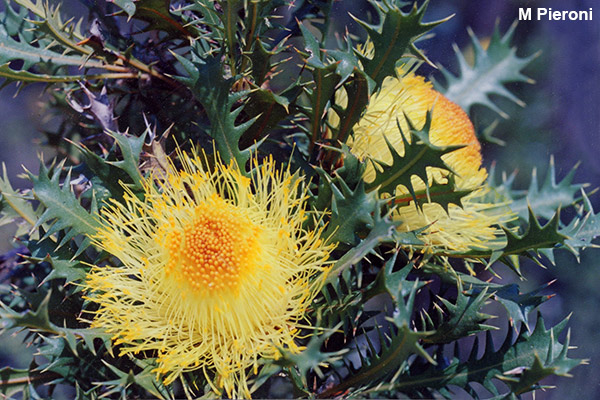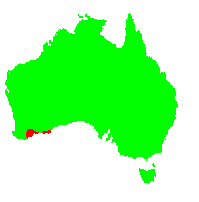General Description:
Banksia is a large genus of over 200 species in the Protea family, having been increased in size through the transfer of species in the former genus Dryandra to Banksia (see footnote box). The genus is almost exclusively Australian, being found in all States and Territories. A single species (B.dentata) is found in islands to Australia’s north as well as in tropical Australia.
Banksia falcata is a small to medium shrub, 0.5 to 2.5 metres in height with an upright habit of growth. The leaves are stiff with very sharply pointed lobes and are somewhat cuneate (wedge shaped) up to 80 mm in length. The individual small flowers occur in bright orange or yellow inflorescences on the ends of short branches. Flowering occurs from spring to mid summer.
B.falcata has been grown by enthusiasts for some years but is not widely cultivated. It can be expected to be difficult to maintain in humid temperate and tropical areas. Excellent drainage and a sunny location are preferred. It is a very attractive species that is deserving of wider cultivation, if the prickly habit is not a deterrent.
Propagation from seed is relatively easy and cuttings may be successful but slow to strike.
A paper published in 2007 proposed that the genus Dryandra be subsumed into Banksia. This revised classification has been accepted by the Council of Heads of Australasian Herbaria and the new Banksia names now appear on Florabase (the website for the Western Australian Herbarium) and in the Australian Plant Census.
The new classification has come in for some criticism but, as the Austraian Plant Census has been adopted as the authority on plant names by ANPSA, the revised classication has been accepted on the ANPSA website. The previous Dryandra names will also be mentioned where appropriate. For further information refer to our Banksia page.

Banksia falcata (syn. Dryandra falcata)
Photo: Margaret Pieroni
Images of all species in the former genus Dryandra can be seen in the Dryandra Study Group’s Dryandra Image Gallery
 Australian Native Plants Society (Australia)
Australian Native Plants Society (Australia)